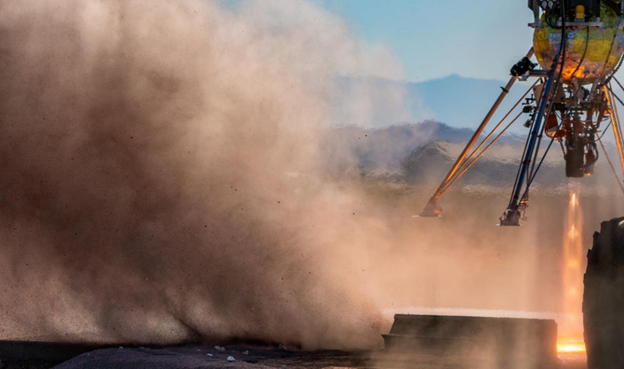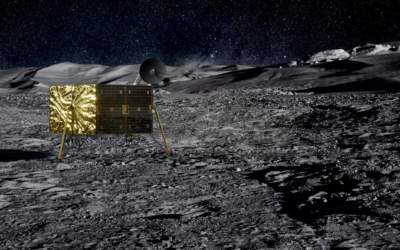We’re building the technologies and infrastructure to enable sustainable access and utilization of our solar system, starting with the Moon. Our goal is to accelerate ecosystems on the Moon, Mars, and beyond to unlock the value in space for humans on Earth. But first we have to solve for the challenging lunar environment, and one of the most pressing hurdles faced by the industry is mitigating lunar dust.
Why is lunar dust so hazardous?
Lunar dust is made up of tiny grains of crushed rock formed by meteorite impacts, effectively creating fragments of glass and mineral. This razor-sharp regolith has always been an issue (lunar dust tore the spacesuits of Apollo astronauts!), but the challenge is amplified for upcoming missions, such as Artemis. Why? Today’s lunar landers proposed for human missions are significantly larger and have more powerful engines.
Artemis landers will have a landed mass of approximately 20 to 60 metric tons compared to approximately 10 metric tons of landed mass during the Apollo era. Engine plumes from these larger landers will create a deep crater and kick up high-velocity regolith that can travel up to 3,000+ meters per second! This regolith can damage the lander, nearby infrastructure, orbital assets, and even endanger astronauts. It can also impact smaller lunar landers carrying important scientific instruments and payloads.

But first… what exactly are FAST Landing Pads?
One approach to mitigate dust damage would require building a landing pad prior to each mission. This traditional approach would be both costly (we estimate more than $120 million per landing pad mission) and subject to a “chicken and egg” dilemma: how do you emplace the pad without landing something in the area first?
In contract, Masten’s FAST approach injects ceramic particles into a rocket engine nozzle to build up a coating over the regolith as spacecraft descend on the lunar surface. The particles impact the surface and solidify to build up a hard landing pad with greater thermal and ablation resistance.
This approach can significantly reduce deep cratering and prevent regolith ejecta from impacting the surrounding environment. That means spacecraft can safely land anywhere on the Moon without the need for a precursor pad construction mission.
The FAST Landing Pads can also maintain their structural integrity to minimize plume effects during an ascent back into lunar orbit.
What did we study in Phase I?
With our partners at Honeybee Robotics, Texas A&M University, and the University of Central Florida (including the renowned plume expert Dr. Phil Metzger!), we fine-tuned our approach during Phase I of the study, which included the following investigations.
- Calculating the optimal landing pad thickness based on the plume effects and pad spalling (i.e., chips, flakes) using data from flying Masten’s vertical takeoff and vertical landing rockets.
- Analyzing materials and particle sizes to ensure they’re the right temperature to adhere to each other on impact and build up layers of landing pad.
- Modeling how the particles absorb and reject heat inside the engine and during travel to the surface.
- Optimizing the deposition rate and required cooling time so the layers can harden into a solid pad while minimizing loiter time of the lander.
- Modeling material adhesion to the regolith to optimize impact velocity and material selection.
- Assessing performance of the solidified material and its effectiveness at mitigating blown dust and deep cratering effects.
- Testing candidate materials with a hot fire rocket engine test that simulates a lunar landing.


What did we learn from the study?
Our analysis determined the FAST concept is feasible for building near-instant landing pads during a lunar descent, even when utilizing an Artemis-scale human lander.
The exact landing pad thickness and material properties will be based on the size and temperature of the engine plume and can be optimized to meet a diverse set of missions.

After the base layer is deposited, alumina particles of approximately 0.024 millimeters in diameter would be required to heat up and liquify as they pass through the engine. These particles would impact the surface at approximately 650 meters per second and create additional layers that build up and strengthen the landing pad. The full deployment would take 10 seconds to release 186 kilograms of alumina at up to 30 meters above the lunar surface, creating a 6-meter diameter landing pad. The pad would then require 2.5 seconds to cool before the vehicle touches down for a safe landing.
What’s next? To the Moon, Mars, and beyond!
In Phase I, we advanced the technology readiness and laid the groundwork for future development. In the next phase, our goal is to further mature the landing pad technology by testing it in a lunar environment. Looking even further ahead, the FAST concept can be applied to other planetary bodies like Mars where loose regolith also poses risks to human and robotic missions.
By mitigating plume effects on the Moon, Mars, and beyond, FAST Landing Pads can keep astronauts, infrastructure, and spacecraft safer while increasing the number of potential landing locations. This technology is also the key to significantly lower total program costs that would be required to build landing pad infrastructure.
In short, FAST Landing Pads can greatly expand accessibility and affordability to planetary bodies, unlocking new scientific discoveries and commercial applications.


